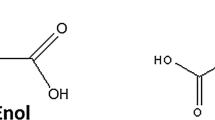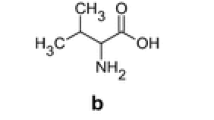Abstract
This research aims to contribute in determining the stability of ammonium succinate and succinic acid in an oxygen-free aqueous medium and exposed to a high radiation field. Both molecules are readily formed in prebiotic experiments and are essential in chemical evolution processes as starting materials for more complex molecules’ formation. Several products were detected, including some N-containing compounds in the ammonium salt experiments. Their formation can be explained via the attack of water radiolysis products. Abstraction and dimerization reactions were the most important in these systems. The decomposition increased with the irradiation dose, giving rise to biologically compounds relevant for chemical evolution processes.




Similar content being viewed by others
References
Deamer D (2011) First life, discovering the connections between stars, cell, and how life began. The University of California Press, Berkeley
Negrón-Mendoza A, Albarrán G (1993) In: Ponnamperuma C, Chela-Flores J (eds) Origin of life. DEEPAK Publishing, Hampton
Draganić IG, Draganić ZD, Adloff JP (1993) Radiation and radioactivity on earth and beyond. CRC Press, Boca Raton
Tilton GR, Steiger RH (1965) Lead isotopes and the age of the earth. Science 150:1805–1808
Mojzsis SJ, Arrhenius G, McKeegan KD, Harrison TM, Nutman AP, Friend CRL (1996) Evidence for life on earth before 3,800 million years ago. Nature 384:55–59
Miller SL, Urey HC (1959) Organic compound synthesis on the primitive earth. Science 130:245–251
Lawless JG, Zeiman B, Pereira WE, Summons RE, Duffield AM (1974) Dicarboxylic acids in Murchison meteorite. Nature 251:40–42
Yuen GU, Kvenvolden KA (1973) Monocarboxylic acids in Murray and Murchison carbonaceous meteorites. Nature 246:301–303
Negrón-Mendoza A, Ponnamperuma C (1976) Formation of biologically relevant carboxylic acids during the gamma irradiation of acetic acid. Origins of life 7:191–196
O’Donnell JH, Sangster DF (1970) Principles of radiation chemistry. American Elsevier Pub. Co., New York
Draganic IG, Draganic ZD (1971) The radiation chemistry of water. Academic Press, New York, pp 204–206
Eisenberg G (1943) Colorimetric determination of hydrogen peroxide. Ind Eng Chem Anal Ed 15(5):327–328
Shriner RL, Fuson RC, Curtin DY (1966) The systematic identification of carbonyl compounds a laboratory manual. Wiley, New York, pp 275–276
Ramírez-Reyes C, Aguilar C (1982) Bacherol thesis, Fac. de Ciencias UNAM, Mexico. http://www.iingen.unam.mx/es-x/Publicaciones/Tesis/Paginas/default.aspx (in spanish)
Shimoyama A, Ponnamperuma C, Yanai K (1979) Amino acids in the Yamato carbonaceous chondrite from Antarctica. Nature 281:394–396
Bednar J (1990) The theoretical foundations of radiation chemistry. Kluwer Academic Publisher, Dordrecht, p 172
Anbar M, Farhataziz, Rose AB (1975) Selected specific rates of reactions of transients from water in aqueous solution. NSRDA US Department of Commerce, Washington, DC
Farhataziz, Ross AB (1975) Select specific rates of reactions of transients from water in aqueous solution. III. Hydroxil radical and perhidroxil radical and their radical ions. NSRDS-NBS, U.S. Govt. Printing Office, pp. 40-43
Tanaka F, Wang CH (1967) Radiolysis of succinic acid in aqueous solution. Int J Appl Radiat Isot 18:761–772
Bartonicek B (1973) Gamma radiolysis of solid succinic acid. Int Radiat Phys Chem 5:361–369
Criquet J, Leitner NKV (2012) Electron beam irradiation of citric acid aqueous solutions containing persulfate. Sep Purif Technol 88:168–173
Criquet J, Leitner NKV (2011) Radiolysis of acetic acid aqueous solutions—effect of pH and persulfate addition. Chem Eng J 174:504–509
Mincher BJ, Curry RD (2000) Considerations for choice of a kinetic fig. of merit in process radiation chemistry for waste treatment. Appl Radiat Isot 52:189–193
Criquet J, Nebout P, Leitner NKV (2010) Enhancement of carboxylic acid degradation with sulfate radical generated by persulfate activation. Water Sci Technol 61:1221–1226
Negrón-Mendoza A, Ramos-Bernal S (2015) Gamma irradiation of isocitric and citric acid in aqueous solution: relevance in prebiotic chemistry. AIP Conf Proc 1671:1
Cataldo F, Ursini O, Angelini G, Iglesias-Groth S, Manchado A (2011) Radiolysis and radioracemization of 20 amino acids from the beginning of the solar system. Rend Lincei Sci Fis Nat 22:81–94
Draganic IG, Draganic ZD, Adloff JP (1990) Radiation and radioactivity on the earth and beyond. CRC Press Inc, Boca Raton
Garzón L, Garzón ML (2001) Radioactivity as a significant energy source in prebiotic synthesis. Orig Life Evol Biosph 31:3–13
Acknowledgements
This work was partially supported by PAPIIT grant IN111116. We thank Chem. Claudia Camargo, M. Sc. Benjamín, Phys. Francisco Flores, and Martín Cruz Villafañe for their technical assistance. We thank to M. Sc. J. Cruz for helping us with the drawings. The present work has totally been carried out in the Laboratory of Chemical Evolution at ICN-UNAM. Special thank to the valuable suggestions of the reviewers.
Author information
Authors and Affiliations
Corresponding author
Rights and permissions
About this article
Cite this article
Negrón-Mendoza, A., Colín-García, M. & Ramos-Bernal, S. Radiolysis of succinic acid and its ammonium salt in aqueous solution: relevance in chemical evolution. J Radioanal Nucl Chem 318, 2279–2284 (2018). https://doi.org/10.1007/s10967-018-6197-2
Received:
Published:
Issue Date:
DOI: https://doi.org/10.1007/s10967-018-6197-2




